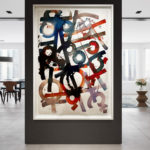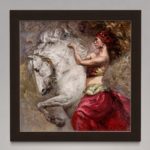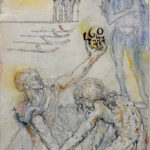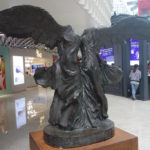Estremadoyro (Peru, b. 1955)
The Liberation
Oil on panel, 52.5″ x 42.3″ (unframed dimensions)
Estremadoyro (Peruvian, b. 1955)
Narcissus’ Awakening
Oil on canvas, 16” x 20”
(unframed)
(Shown at Peruvian Consulate, Washington DC, July 2009)
The Painter and the Model.
The Painter and the Model is a project I started to imagine when I lived in Paris. The idea was to create a series, using as a model a girl of Indian origin from Peru; of a different generation, of a social and cultural class opposite to mine, and having the conditions not only physical but mental and spiritual above all, to fulfil this work with me.
I would not have preconceived ideas for the paintings: it would be the paintings and the drawings that should tell the story of this encounter.
The paintings represent the day, the aware and bright side: they would be responsible for telling the ‘official history’. The drawings represent the night, the secret and dark side of this tale: they would be responsible for telling the ‘other story’. But as in life -where there are some days that feels like nights, and some nights that feels like days, it would also be some drawings that will seem like paintings; and even some paintings, that will seem like drawings…
This project is now a work in progress. The whole idea of the series is finished and my work with the girl too. This is a suite of paintings and drawings, which are currently at different stages of completion.
Narcissus Awakening.
The first painting in this series is Narcissus Awakening.
This painting is an allegory; and talks about a moment of grace: the girl that would become my model sees its own image ‘appear’ in the puddle of water. Because this is not a reflection but an apparition, what she sees on the surface of the water. This is not a natural fact, as it would be a reflection, but as the art, this is the result of the whim and will of man. Because this pool and this water represents art: the girl sees her image appearing in my own artwork and, like Narcissus, falls in love. Then she decides to be a model. That’s the reason why this is the first painting of the series. Thus begins this story.
The looming figure, above left, is a Bouguereau’s Cupid. And he comes in the name of the art of painting, for sticking an arrow to the model. But if the Cupid is of this painter, this is not a simple coincidence: our young Indian girl, that didn’t knew nothing of painting or painters, with genuine enthusiasm reviewed all my books and files of paintings. At the end she concluded that the painter of painters was none other than that great French Master… So if she was the model, the Cupid could not be of another painter than William Bouguereau…
Estremadoyro (Peru, b. 1955)
The One (She was)
2006
Pencil on paper, 18.25″ x 22.3″
Estremadoyro (Peru, b. 1955)
Second Sight
2007
Colored Pencil on paper, 18.25″ x 22.3″
18/LE MONDE/FRIDAY, JANUARY 3, 1997 “An extraordinary Peruvian painter.”
In a very formal exhibit, a not so formal painting.
ESTREMADOYRO has lived several years in France. This Peruvian artist of extremely unusual paintings continues, however, not being very well known in our country. Within the setting of the barely-accustomed-to-scandals International Diplomatic Academy (Académie diplomatique internationale), who organizes an exhibition to celebrate its 70th anniversary, he has on display a remarkable work, only one, but it is out of the ordinary and fiercely up to date. Its name is The Eve (La Víspera), and it is nothing less than a depiction of our times, saturated with horrors, and of our memory, saturated with references. There is immense ambition: To restore the great classic peinture d’histoire, and to delve deeply into the theme. To achieve this, Estremadoyro uses simultaneously the realistic pictorial style of effective illusionistic techniques, and pseudo-collages1 that let him insert fragments of illustrious works: Leonardo, Vermeer, Velázquez. This is how the mental confusion is suggested, the spiritual disorder, and a sort of observant hallucination that captivates you. There are abundant symbols of suffering and oppression, as well as many allusions to contemporary history.
–TRANSLATION OF AN ARTICLE IN THE DAILY LE MONDE BY ART CRITIC PHILIPPE DAGEN, PUBLISHED BY SAID NEWSPAPER ON JANUARY 3, 1997.
I am a Peruvian painter who for almost thirty years has pursued the same struggle. About 1975, when I was some twenty years old, I understood that modern art was finished and that it was essential to return to the great tradition of the Painting of the Old Masters. But it was one thing to think it, and very much something else to do it: Who could teach me?… No one, apparently. That was the beginning of many years of solitary and misunderstood effort to master the craft. After many failures with oil paint, I decided to concentrate on drawing. From those years are works such as these:
In the decade of the nineties I went to France, invited as a Professor at the École Nationale des Beaux-Arts in Paris, by recommendation of Professor Henry Cueco. Obviously I felt very excited by this invitation. No Peruvian painter had ever had the honour of being a Professor at the school of Ingres and Bouguereau …
When I was introduced to the students, they were told that I was a painter who mastered the techniques of Painting that they (the French) had forgotten; hence the reason for my presence at the School. Let me be completely honest, Mr. Ross. Inside me I was saying: “How sad things are! … If we were in the time of Ingres I would be coming here to learn, not to teach”. And with all sincerity I tell you that I would have preferred a thousand times to learn from one of those great masters than to be invited as a Professor. But I can also say that at that point I did not know just how bad everything was. You do know! You say so clearly in your articles and on many other occasions. Teaching art has become a fraud and a deception and, certainly, l’École des Beaux-Arts is no exception. On the contrary. Soon I would come to feel that the School was the saddest place in Paris.
When I wanted to start teaching Painting, they immediately talked me out of it: “This is a school for Artists,” – they advised, “but if you want to teach a scholarly craft, then … allez-y!” Conversely, the students that were interested in learning, were also under intense pressure: “What will they think of us if they see us painting still lifes!” they told me… At the School of Fine Arts it was simply shameful to learn or to teach Painting!
This experience in Paris persuaded me to paint a very large picture of 200 x 300 cm, which I called The Eve on which I worked during four years in a small 4 x 3 m studio in the banlieue of Paris. This painting reflects the anguish I felt as a painter facing the state of affairs of the arts and the society, on the eve of the new century. I was painting the day before, unaware of what tomorrow would be like, although I was sustained by the hope that during the 21st Century, great changes would be forthcoming. The insanity of the 20th Century could not last forever …
Mr. Philippe Dagen, art critic of the daily newspaper Le Monde, and France’s most important art critic at that time, was one of the few who provided me support during that period. Follows a reproduction of the article he published in Le Monde, and its translation into English:
18/LE MONDE/FRIDAY, JANUARY 3, 1997
An extraordinary Peruvian painter.
In a very formal exhibit, a not so formal painting.
LUIS JOSE ESTREMADOYRO has lived several years in France. This Peruvian artist of extremely unusual paintings continues, however, not being very well known in our country. Within the setting of the barely-accustomed-to-scandals International Diplomatic Academy (Académie diplomatique internationale), who organizes an exhibition to celebrate its 70th anniversary, he has on display a remarkable work, only one, but it is out of the ordinary and fiercely up to date. Its name is The Eve (La Víspera), and it is nothing less than a depiction of our times, saturated with horrors, and of our memory, saturated with references. There is immense ambition: To restore the great classic peinture d’histoire, and to delve deeply into the theme. To achieve this, Estremadoyro uses simultaneously the realistic pictorial style of effective illusionistic techniques, and pseudo-collages1 that let him insert fragments of illustrious works: Leonardo, Vermeer, Velázquez. This is how the mental confusion is suggested, the spiritual disorder, and a sort of observant hallucination that captivates you. There are abundant symbols of suffering and oppression, as well as many allusions to contemporary history.
TRANSLATION OF AN ARTICLE IN THE DAILY LE MONDE BY ART CRITIC PHILIPPE DAGEN, PUBLISHED BY SAID NEWSPAPER ON JANUARY 3, 1997.
Through all that was said above, you can easily visualize the wonderful surprise and intense emotion I felt upon discovering the ARC page and the endeavors you are undertaking. I have written these lines to congratulate you heartily, and to share with you my own experience and my solitary combat for a cause that is common to both of us.
So, I am left with the feeling that finally, and after all, my struggle for the revival of the Arts and Painting is no longer quite as lonely. I now hold more and more hopes that the beginning new century will bring a true transformation on this regard. And that this will be achieved despite the great thunderclouds and anxiety under which this new era is getting started.
I am at your disposal for any project that might contribute toward the achievement of this objective, and I shall look forward with pleasure to your kind response.
Yours very truly,
LJE
Estremadoyro (Peruvian, b. 1955)
Narcissus’ Awakening
Oil on canvas, 16” x 20”
(unframed)
$12,500.
(Shown at Peruvian Consulate, Washington DC, July 2009)
The Painter and the Model.
The Painter and the Model is a project I started to imagine when I lived in Paris. The idea was to create a series, using as a model a girl of Indian origin from Peru; of a different generation, of a social and cultural class opposite to mine, and having the conditions not only physical but mental and spiritual above all, to fulfil this work with me.
I would not have preconceived ideas for the paintings: it would be the paintings and the drawings that should tell the story of this encounter.
The paintings represent the day, the aware and bright side: they would be responsible for telling the ‘official history’. The drawings represent the night, the secret and dark side of this tale: they would be responsible for telling the ‘other story’. But as in life -where there are some days that feels like nights, and some nights that feels like days, it would also be some drawings that will seem like paintings; and even some paintings, that will seem like drawings…
This project is now a work in progress. The whole idea of the series is finished and my work with the girl too. This is a suite of paintings and drawings, which are currently at different stages of completion.
Narcissus Awakening.
The first painting in this series is Narcissus Awakening.
This painting is an allegory; and talks about a moment of grace: the girl that would become my model sees its own image ‘appear’ in the puddle of water. Because this is not a reflection but an apparition, what she sees on the surface of the water. This is not a natural fact, as it would be a reflection, but as the art, this is the result of the whim and will of man. Because this pool and this water represents art: the girl sees her image appearing in my own artwork and, like Narcissus, falls in love. Then she decides to be a model. That’s the reason why this is the first painting of the series. Thus begins this story.
The looming figure, above left, is a Bouguereau’s Cupid. And he comes in the name of the art of painting, for sticking an arrow to the model. But if the Cupid is of this painter, this is not a simple coincidence: our young Indian girl, that didn’t knew nothing of painting or painters, with genuine enthusiasm reviewed all my books and files of paintings. At the end she concluded that the painter of painters was none other than that great French Master… So if she was the model, the Cupid could not be of another painter than William Bouguereau…
The Painter and the Model is a true story, which takes place in thirteen paintings and eleven drawings. Soon I’ll begin to publish the first drawings of this series.












